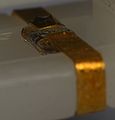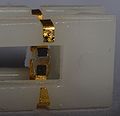S-1: Difference between revisions
No edit summary |
No edit summary |
||
| Line 11: | Line 11: | ||
|manuals= | |manuals= | ||
* [[Media:070-0763-00.pdf|Tektronix S-1 Manual]] (OCR) | * [[Media:070-0763-00.pdf|Tektronix S-1 Manual]] (OCR) | ||
* [[Media:Tek s-1 whole foldouts.pdf|Tektronix S-1 Manual Foldouts]] (whole, color) | |||
* [[Media:Tek type S-1 factory cal proc.pdf|Tektronix Type S-1 Factory Calibration Procedure (PDF)]] | * [[Media:Tek type S-1 factory cal proc.pdf|Tektronix Type S-1 Factory Calibration Procedure (PDF)]] | ||
}} | }} | ||
Revision as of 05:59, 10 December 2023
The S-1 sampling plug-in head provides a single GR-874 50 Ω input with a 350 ps rise-time.
The S-1 can be used with the 7000 series of sampling plug-ins, as well as the 3S series of sampling units.
Key Specifications
| Rise time | 350 ps |
|---|---|
| Bandwidth | 1 GHz |
| Operating input voltage range | −1 V to +1 V with ≤1 Vp-p signals |
| Maximum single sample step | 500 mV |
| Maximum input voltage | ±5 VDC or sine of 10 Vp-p up to 10 MHz |
| Input impedance | 50 Ω ±1% (GR-874) |
| Noise | < 2 mV |
| Features | trigger pickoff for internal triggering |
Links
Internals
The S-1 uses a two-diode sampling gate which has relatively high "kick-out" (leakage of the strobe signal out of the input).
The manual cautions,
Operating the sampling head without the input connector terminated by a 50 Ω resistor or coaxial cable will cause a vertical shift of the zero signal baseline by a few millivolts. This is caused by the strobe kickout signal being reflected from the open input connector, and arriving back at the sampling bridge while the bridge is conducting.
The sampling bridge strobe signal is generated by an avalanche transistor followed by a step recovery diode, called snap-off diode in Tek lingo.
Pictures
-
-
Strobe board
-
Preamp board
-
S-1 front
-
Diode mount in S-1
-
Diode mount in S-1
-
Diode mount in S-1
-
Tektronix S-1 sampler
-
7S11 with S-1










